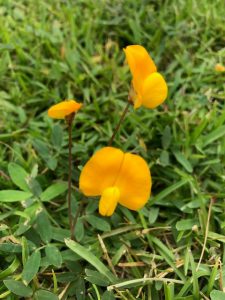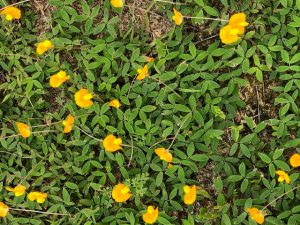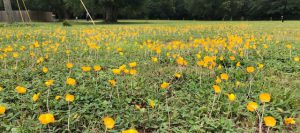
The bright yellow perennial peanut flower is not only pretty, but edible! Photo credit: Carrie Stevenson, UF IFAS Extension
It’s bright yellow, makes its own fertilizer, and tastes like peanut butter. On my morning walks around the track at our office, I have noticed lately that the perennial peanut (Arachis glabrata) is growing lushly, fulfilling its role as a low maintenance groundcover. The plant thrives in hot weather, full sun, and humidity, so we have nearly reached peak growing conditions for this South American native.
Perennial peanut was brought in from Brazil almost 90 years ago as a valuable hay crop and livestock forage. It is still used regularly for these purposes. However, as years of experience have borne out, there are no insect, disease, or unwanted invasive issues with the plant. The lush green groundcover has been used in the past few decades as a popular turfgrass alternative. It is drought and salt tolerant, and can thrive in low-nutrient, sandy soils.

Perennial peanut is a drought-resistant, salt-tolerant, erosion-managing groundcover. Photo credit: Carrie Stevenson, UF IFAS Extension
Its bright yellow blossoms are delicate and almost orchid-like in shape, standing upright on a thin stem. As mentioned earlier, the flower is also edible and has a very light peanut flavor. The foliage, a deep green with compound leaves, lies close to the ground. Its spreading rhizomes serve as an excellent erosion control method, holding even easily washed out sandy soils in place.
Like its more well-known cousin, the perennial peanut is a legume, which means it can “fix” atmospheric nitrogen, transforming it into a form the plant can use. For a homeowner, this means you do not need to add nitrogen fertilizer. If phosphorus levels are naturally high enough in the soil (as is often the case in south Florida), only small amounts potassium-magnesium sulfate may be needed.
Perennial peanut is best utilized in open spaces without high foot traffic. If you’d like to see it, come out to the Escambia Extension office; there’s a large swath of it between our main building and the demonstration garden near the walking path. If you are interested in planting or maintaining it, check out these documents from UF IFAS Extension or watch this informative video from a colleague!
- Hurricane Season 2025 - July 7, 2025
- The Striped Burrfish - April 11, 2025
- The Value of Biodiversity - March 28, 2025

